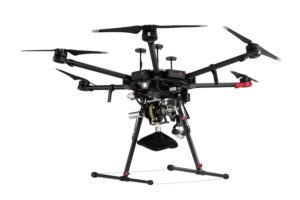Blog entry by Bruce McPherson

We wrote about DroneUp’s drone delivery of Coke with Coffee to residents in Coffee, GA – but how exactly did that delivery work? The A2Z Rapid Delivery System allowed packages to be delivered without landing the drone – a method that solves a lot of problems in drone delivery.
CA-based A2Z Drone Delivery, LLC, has developed a patented tethered freefall drone delivery mechanism, the Rapid Delivery System (RDS1) used by DroneUp® for the project with Walmart and Coke. The RDS1 system lowers the delivery to the ground by tether – which means that homeowners don’t have to worry about a noisy landing or the potential for a landing drone to hit obstacles on its way down. “The RDS1 was chosen for its rapid delivery capabilities which reduced time-on-station to just 30 seconds per delivery, while minimizing intrusive rotor noise and limiting the window for risk to people on the ground,” says an A2Z press release.
“For our partners at DroneUp to put their trust in our system was the best proof of concept that we could imagine and was a memorable benchmark for our whole team,” said Aaron Zhang, founder of A2Z Drone Delivery, LLC. “The unique capabilities of the RDS1 were tailor-made for this type of residential delivery where our tethered freefall mechanism can accurately and quickly deposit payloads while hovering far from people, homes, trees and utility wires.”
Many of the concerns about the safety of drone delivery – and the impact on communities – is based upon the very end of the mission, when the drone lands.
“By delivering payloads without having to descend from cruising altitude, the A2Z Drone Delivery RDS1 mitigates the safety and privacy concerns often associated with drone delivery by keeping spinning UAV propellers away from people and abating intrusive rotor noise of low-flying drones,” says the press release.
“With the innumerable logistics that go into residential drone delivery, it’s important to have confidence in every aspect of the hardware from the UAV platform to the delivery mechanism,” said John Vernon, the CTO of DroneUp. “The RDS1 allows our pilots to reduce time-on-station to about 30 seconds per delivery. Combined with the ability to make deliveries from cruising altitude, this rapid delivery and the integrated safety features in the tether system itself, help us assuage some of the public concerns over UAV delivery.”
A2Z’s RDS1 is designed to meet the concerns of regulators and consumers, says the company:
To ensure payloads are secure throughout the flight, the RDS1 features extensive integrated safeguards. An automated pre-flight weight check ensures the flight platform is not overloaded before the RDS1’s built-in payload status detection monitors track the payload throughout flight and delivery. Manual delivery control is backed up by intelligent safeguards that calculate the payload freefall and when to slow the descent to the ground, while a passive payload lock protects against package loss in the event of a power fluctuation. Should the UAV experience an emergency, the payload and tether can be abandoned to save the aircraft, and protect the safety of people and property on the ground.
“No matter how many flight hours you have as a UAV pilot, adding the dynamic of delivering packages to the ground is still a new concept, so having the tether controls seamlessly integrated into the pilot software is imperative,” said DroneUp pilot Ethan Burnette, who flew delivery missions with the RDS1. “Also, knowing the redundant safety systems are in place gives you the added peace of mind you need as you become accustomed to flying a drone with a payload slung below it.”
By: Miriam McNabb DroneLife